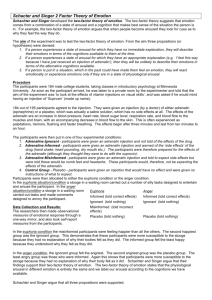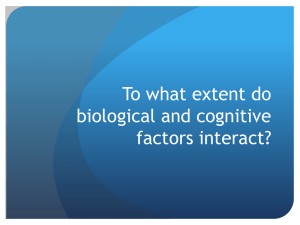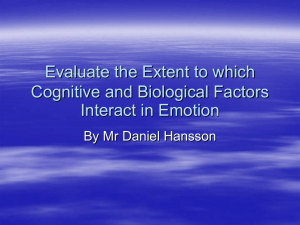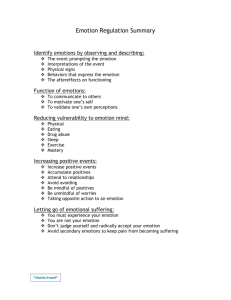Cognitive and Biological factors interact
advertisement
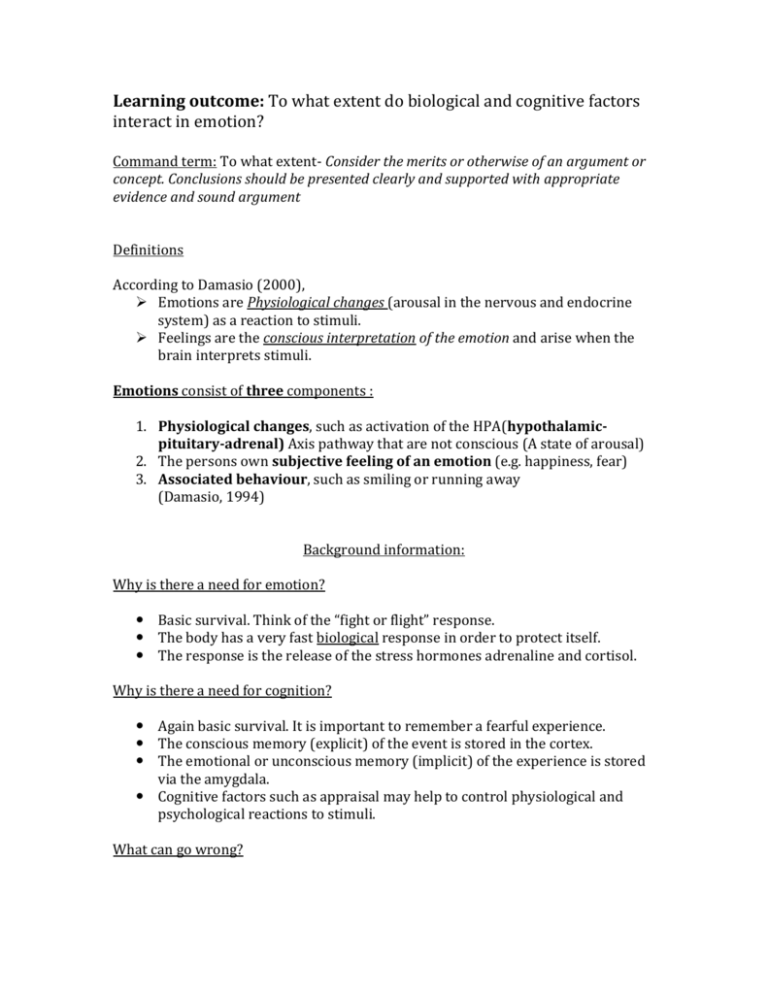
Learning outcome: To what extent do biological and cognitive factors interact in emotion? Command term: To what extent- Consider the merits or otherwise of an argument or concept. Conclusions should be presented clearly and supported with appropriate evidence and sound argument Definitions According to Damasio (2000), Emotions are Physiological changes (arousal in the nervous and endocrine system) as a reaction to stimuli. Feelings are the conscious interpretation of the emotion and arise when the brain interprets stimuli. Emotions consist of three components : 1. Physiological changes, such as activation of the HPA(hypothalamicpituitary-adrenal) Axis pathway that are not conscious (A state of arousal) 2. The persons own subjective feeling of an emotion (e.g. happiness, fear) 3. Associated behaviour, such as smiling or running away (Damasio, 1994) Background information: Why is there a need for emotion? Basic survival. Think of the “fight or flight” response. The body has a very fast biological response in order to protect itself. The response is the release of the stress hormones adrenaline and cortisol. Why is there a need for cognition? Again basic survival. It is important to remember a fearful experience. The conscious memory (explicit) of the event is stored in the cortex. The emotional or unconscious memory (implicit) of the experience is stored via the amygdala. Cognitive factors such as appraisal may help to control physiological and psychological reactions to stimuli. What can go wrong? If there is a biological fear response which does not subside after rational thought then this is a problem. This is the case in anxiety, phobia, panic disorders and PTSD. There is no conscious control of these responses. There are different theories about how cognitive and biological factors interact in emotion. Schachter and Singer (1962) Two-factor theory LeDoux’s (1999) theory of the emotional brain Lazarus (1975) Appraisal theory Schachter and Singer (1962) Two-factor theory The two-factor theory suggests that emotion comes from a combination of: 1. A state of physiological arousal and 2. A cognition that makes best sense of the situation the person is in. For example, the two-factor theory of emotion argues that when people become aroused they look for cues as to why they feel the way they do. Evidence: Schachter & Singer (1962) study on the two-factor theory of emotion The aim of the experiment was to test the two-factor theory of emotion. These were their hypotheses: 1. If a person experiences a state of arousal for which they have no immediate explanation, they will describe their emotions in terms of the cognitions available to them at the time (e.g. ‘I feel this way because that person is annoying me’). 2. If a person experiences a state of arousal for which they have an appropriate explanation (e.g. ‘I feel this way because I have just received an injection of adrenalin’), then they will be unlikely to describe their emotions in terms of the alternative cognitions available. The participants were 184 male college students, taking classes in introductory psychology at Minnesota University. An independent measures design was used. For the procedure, as soon as the participant arrived, he was taken to a private room by the experimenter and told that the aim of the experiment was ‘to look at the effects of vitamin injections on visual skills’, and was asked if he would mind having an injection of ‘Suproxin’ (made up name). 184 out of 195 participants agreed to the injection. They were given an injection (by a doctor) of either adrenalin or a placebo, which was actually a saline solution, which has no side effects at all. The effects of the adrenalin are an increase in blood pressure, heart rate, blood sugar level, respiration rate, and blood flow to the muscles and brain, with an accompanying decrease in blood flow to the skin. This is often experienced as palpitations, tremors, flushing and faster breathing. The effects begin after three minutes and last from ten minutes to an hour. The participants were then put in one of four experimental conditions (IVs): 1. Adrenalin Ignorant - participants were given an adrenalin injection and not told of the effects of the drug. 2. Adrenalin Informed - participants were given an adrenalin injection and warned of the ‘side effects’ of the drug (hand shake, heart pounding, dry mouth etc.). The participants were therefore prepared for the effects of the adrenalin (although they thought they were to do with the suproxin). 3. Adrenalin Misinformed - participants were given an adrenalin injection and told to expect side effects but were told these would be numb feet and headache. These participants would, therefore, not be expecting the effects of the adrenalin. 4. Control Group - Placebo - participants were given an injection that would have no effect and were given no instructions of what to expect. Participants were then allocated to either the euphoria condition or the anger condition. In the euphoria situation a confederate in a waiting room carried out a number of silly tasks designed to entertain and amuse the participant. In the anger situation a confederate in a waiting room carried out tasks and made comments designed to annoy the participant. The researchers then made observational measures of emotional response through a one-way mirror, and also gave self-report questionnaires to the participants (DVs). For their findings, in the euphoria condition the misinformed participants were feeling happier than all the others. The second happiest group was the ignorant group. This demonstrates that these participants were more susceptible to the confederate because they had no explanation of why their bodies felt as they did. The informed group felt the least happy because they understood why they felt as they did. In the anger condition, the ignorant group felt the angriest. The second angriest group was the placebo group. The least angry group was those who were informed. Again this shows that participants were more susceptible to the confederate because they had no explanation of why their body felt as it did. • • • Schachter and Singer concluded that their findings support their two-factor theory of emotion. The two-factor theory of emotion states that the physiological arousal in different emotions is entirely the same and we label our arousal according to the cognitions we have available. Schachter and Singer argue that their hypotheses were supported. Evaluations: Evaluation of the two factor theory: The two-factor theory of emotion has been an influential theory of emotion. However subsequent work has shown that the relationship is more complex than the two-factor theory predicts. For example psychologists now argue that peoples efforts to understand an unexplained state of arousal is more extensive than a quick examination of cues in the surrounding environment. When we seek to explain a state of arousal, we don’t merely use others’ behaviour but call on many other sources of information as well, particularly our own past history - we search for prior occasions on which we felt this arousal state to explain its occurrence now. Introduction to LeDoux’s LONG and SHORT route theory of the emotional brain The Brain Biological and Cognitive interactions in the brain The Amygdala is specialized for the processing of emotion. According to Phelps (2004) it helps in storing and classifying emotionally charged memories so that emotional events receive priority. It plays a large role in processing our emotions, especially fear. It's been found to trigger responses to strong emotion such as sweaty palms, freezing, increased heartbeat/respiration and stress hormone release. Humans with damage to the amygdala do not experience fear in dangerous situations. The Hippocampus It's primary role is in memory formation (semantic and episodic), classifying information, long-term memory. Like the RAM in your computer it processes and stores new and temporary memory for long term storage. LeDoux’s LONG and SHORT route theory of the emotional brain LeDoux’s model Explaining the model The short route: Emotional stimulus is first processed in the thalamus, which sends a signal to the amygdala. The amygdala immediately activates response systems. Useful if there is immediate danger. AT THE SAME TIME The long route: The sensory input goes via the sensory cortex to the hippocampus for closer inspection. This involves evaluation of the stimulus and consideration of an appropriate response which is fed back to the amygdala. This links with the concept of cognitive appraisal, Lazarus 1975 Explaining the theory: It is an advantage that humans’ emotional reactions are flexible. There is an instant response to detected danger for the purpose of survival (the short route). This saves time and could be important in matters of life and death. Humans have also evolved “emotional feeling” i.e a conscious experience of the emotion which helps to evaluate the level of danger before a response (the long route). This can help people and animals to avoid inappropriate responses to situations. Lazarus (1975) Appraisal theory This theory states that cognitive factors can control stress responses. People’s reaction to emotional stress and stressful experiences are not only physiological but also psychological. According to Lazarus (1975) appraisals are evaluations related to how the situation will impact on ones personal well-being. Positive emotions (or feelings) emerge if the appraisal assesses potential benefit. Negative emotions (or feelings) emerge if the appraisal assesses potential harm. People are psychological beings who are not simply passively responding to the world. They actively interpret and evaluate what is happening to them. CLOA principle Evidence: Speisman et al (1964) Experimental manipulation of emotions through cognitive appraisal Aim: Can the manipulation of cognitive appraisal influence emotional experience? Method: Laboratory experiment. Participants were shown an anxiety evoking film (aboriginal initiation ceremony where boys were subjected to genital cutting-circumcision). 3 different soundtracks were played to manipulate the cognitive appraisal of a situation. Trauma condition, emphasized mutilation (use of sharp knife) and pain Intellectualization condition, gave an anthropological interpretation of the ceremony. Denial condition, showed the boys being willing and happy in the ceremony Silent condition. There was no soundtrack. During the viewing of the film, physiological measures were taken such as heart rate. Results: The trauma condition showed much higher physiological measures of stress. It was lowest in the intellectualization and silent conditions. This shows that it is not the event itself that elicited the emotional stress, but the ‘appraisal’ of it. When the cognitive appraisal of a situation is manipulated (i.e. to be more traumatic), it influences emotion (the physiological stress response). Evaluation: +The study demonstrates how biological and cognitive factors interact. + Does also support Le Doux’s theory as cognitive appraisal involves the hippocampus. + Laboratory experiment with rigorous control to show cause and effect… BUT - Lacks ecological validity as it does not show cognitive appraisal in a real life situation. -Ethical issues. Use of deception and psychological stress of participants. Summary of the interaction of emotion and cognition Cognitive and biological factors do, to a large extent, interact in emotion. However, the way they interact is complex and not fully understood. Emotions influence cognitive processes such as memory. Cognitive processes such as appraisal influence emotions. The physiology of emotion is still not fully understood. Questions: • Complete the following table. Role of… Le Doux Schacter-Singer Lazarus Biological factors Cognitive factors Read the following study: Dutton and Aron, 1974: The participants were unsuspecting males, aged 18-35, visiting the Capilano Canyon in Canada. An attractive female interviewer approached the men and asked them questions as part of a survey on the effects of scenery and creativity. One of the things they were asked to do was to invent a short story about an ambiguous picture of a woman. This was later scored for sexual content, taken to reflect the men’s sexual attraction towards the interviewer. Some men were interviewed on an extremely unstable suspension bridge, 5 feet wide and, 450 feet long, composed of wooden board attached to wire cables, running from one side of the canyon to the other. It was 230 feet above the canyon and tended to sway, tilt and wobble, giving the impression that one could fall over the side at any moment. It only had very low handrails of wire cable for support. Other men were interviewed on a solid wooden bridge, a mere 10 feet above a shallow rivulet, with high handrails and without swaying or tilting. The stories of men from the high bridge contained significantly more sexual imagery. The interviewer also invited the men to call her if they wanted more information about the research. Four times as many men from the high bridge called her compared to the low bridge. Another group of men were interviewed 10 minutes after they had crossed the high bridge. They did not have the same level of sexual content as the high bridge condition. Questions: 1. Which theory of emotion does this study provide support for? 2. Explain the results based on the theory you have chosen. 3. Evaluate this study.




